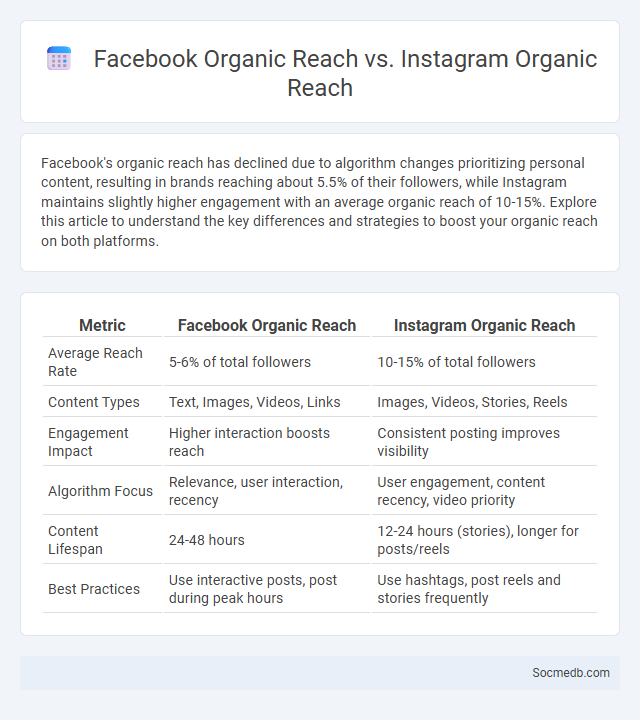
Photo illustration: Facebook Organic Reach vs Instagram Organic Reach
Facebook's organic reach has declined due to algorithm changes prioritizing personal content, resulting in brands reaching about 5.5% of their followers, while Instagram maintains slightly higher engagement with an average organic reach of 10-15%. Explore this article to understand the key differences and strategies to boost your organic reach on both platforms.
Table of Comparison
| Metric | Facebook Organic Reach | Instagram Organic Reach |
|---|---|---|
| Average Reach Rate | 5-6% of total followers | 10-15% of total followers |
| Content Types | Text, Images, Videos, Links | Images, Videos, Stories, Reels |
| Engagement Impact | Higher interaction boosts reach | Consistent posting improves visibility |
| Algorithm Focus | Relevance, user interaction, recency | User engagement, content recency, video priority |
| Content Lifespan | 24-48 hours | 12-24 hours (stories), longer for posts/reels |
| Best Practices | Use interactive posts, post during peak hours | Use hashtags, post reels and stories frequently |
Understanding Organic Reach: Definition and Importance
Organic reach on social media refers to the number of unique users who see your content without paid promotion. It is a critical metric for measuring authentic audience engagement and brand visibility. Maximizing organic reach enhances credibility and fosters genuine connections with followers.
Facebook Organic Reach: Key Features and Trends
Facebook organic reach highlights how your content naturally appears in user feeds without paid promotion, influenced heavily by algorithm updates prioritizing meaningful interactions. Key features include engagement metrics such as comments, shares, and reactions that boost visibility, as well as the importance of posting relevant, high-quality content consistently. Current trends show a decline in organic reach for branded pages, underscoring the need for strategic content planning and community building to maintain Your audience's attention effectively.
Instagram Organic Reach: Key Features and Trends
Instagram organic reach depends heavily on content quality, audience engagement, and consistent posting schedules to maximize visibility. You can enhance organic reach by leveraging Instagram Stories, Reels, and interactive features like polls and questions that encourage user interaction. Recent trends emphasize authentic storytelling and community-building, which significantly improve your brand's presence without relying on paid promotion.
Factors Influencing Facebook Organic Reach
Facebook organic reach is primarily influenced by algorithm changes, user engagement rates, and content relevance. High-quality, engaging posts that encourage likes, comments, and shares tend to perform better in users' news feeds. Timing of posts and the use of multimedia elements like videos and images also significantly impact organic visibility on the platform.
Factors Influencing Instagram Organic Reach
Instagram organic reach is influenced by factors such as content quality, audience engagement, posting frequency, and the use of relevant hashtags. The platform's algorithm prioritizes posts that receive higher interaction rates, encouraging you to create compelling visuals and captions that resonate with your followers. Timing and consistency also play crucial roles in maximizing visibility and sustaining audience interest over time.
Algorithm Differences: Facebook vs Instagram
Facebook's algorithm prioritizes content based on meaningful interactions, such as comments and shares, emphasizing family and friend connections, while Instagram focuses on user engagement metrics like likes, saves, and time spent on posts, driven by interests and relevancy. Your content on Facebook should encourage conversations to increase visibility, whereas on Instagram, visually appealing posts and timely interaction boost reach. Understanding these algorithmic differences is crucial for optimizing your social media strategy across both platforms.
Audience Engagement: Facebook vs Instagram
Facebook offers robust tools for audience engagement through detailed group interactions and event promotions, allowing you to build communities and drive meaningful conversations. Instagram excels in visual storytelling with features like Stories, Reels, and interactive stickers that boost real-time engagement and emotional connections. Choosing the right platform depends on your content style and whether your goal is deeper community involvement or visually-driven audience interaction.
Content Strategies for Maximizing Organic Reach
Creating compelling, shareable content tailored to your target audience significantly boosts organic reach on social media platforms. Leveraging platform-specific features like Instagram Reels, TikTok videos, and LinkedIn articles enhances visibility and engagement without paid promotion. Consistent posting schedules combined with authentic storytelling and community interaction help foster stronger connections and increased algorithm favorability for your brand.
Measuring and Analyzing Organic Reach Performance
Tracking organic reach performance on social media involves analyzing metrics such as impressions, engagement rate, and follower growth to understand how your content resonates without paid promotion. Utilizing platform analytics tools like Facebook Insights or Instagram Analytics helps you identify which posts generate the most organic interaction, enabling data-driven decisions to optimize future content strategy. You can improve your organic presence by consistently monitoring trends, audience behavior, and adjusting posting times based on peak user activity.
Conclusion: Choosing the Best Platform for Organic Growth
Selecting the best social media platform for organic growth depends on your target audience, content type, and engagement goals. Platforms like Instagram and TikTok excel in visual storytelling, while LinkedIn suits professional networking and B2B content. Tailoring your strategy to your unique niche maximizes organic reach and fosters authentic connections with your audience.
 socmedb.com
socmedb.com